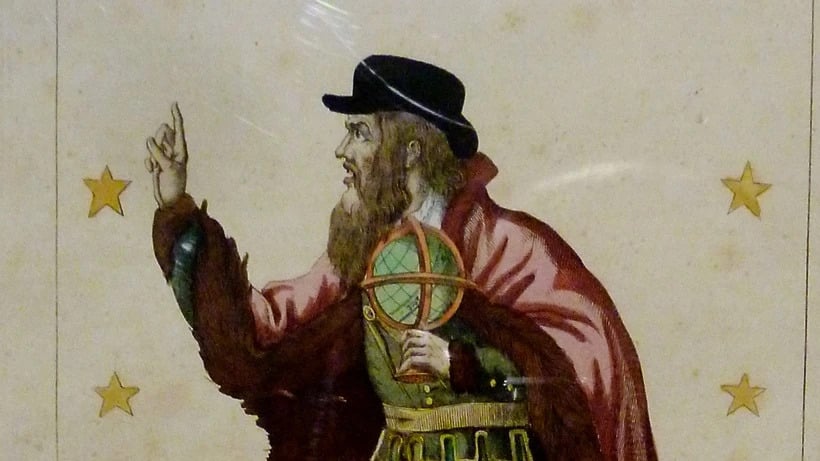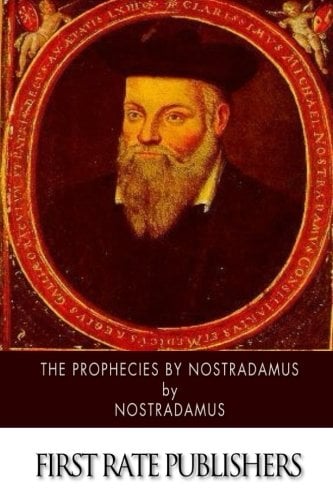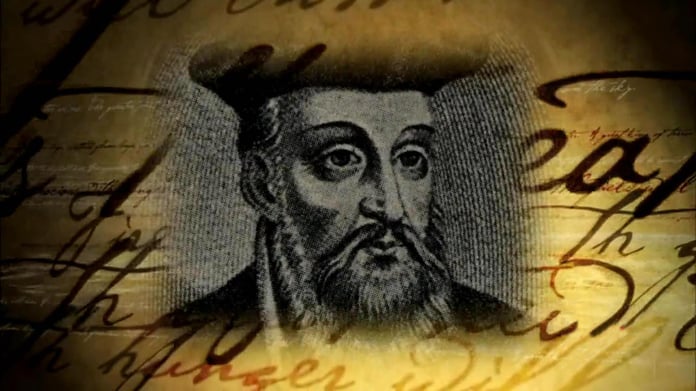It is believed that on March 1, 1555, Michel de Nostradamus published a book of predictions. For four and a half centuries, many historians, cryptographers, and enthusiasts have been trying to unravel the messages encrypted in this book.
Fact 1. Not all “Predictions” of Nostradamus are considered genuine
The book ‘Les Prophéties‘ was first published in 1555. The tome consisted of 353 quatrains and was preceded by a preface message to the son of Nostradamus, Cesar, who was barely a year old at that time. Over the next three years, the book was reprinted twice, supplemented with new quatrains.
In 1566, Michel de Nostradamus died from complications of gout. Despite this, in 1568 an expanded new edition with new quatrains was published, and in subsequent years the book was reprinted several times, while dozens of quatrains appeared in it, which were allegedly found by chance among the astrologer’s papers.

One of Nostradamus’s books of predictions also had an original preface – a message to Henry II, where the soothsayer promised the king dominion over many lands of the world. Historians cannot accurately date this message; perhaps it was added after the death of Nostradamus. Likewise, the reliability of the quatrains “discovered” after the death of Nostradamus is questioned by a number of researchers. Nostradamus himself never counted the number of quatrains he wrote.
Fact 2. Contemporary astrologers criticized the book of Nostradamus
As a youth, Michel de Notredame studied at the University of Avignon, where the fundamental sciences, in addition to rhetoric, logic, geometry, and arithmetic, also included astrology. The ability to read the fate of the world from the stars was considered important; people attached great importance to the opposition of planets and eclipses. Scientists believed that the location of celestial bodies on the celestial sphere could influence events that occur on Earth, as well as dictate the motives and decisions of kings and generals.
However, when Nostradamus published his work, astrologers of that time wrote to him: “In true astrology, you understand less than nothing.” The book of predictions was considered unreliable by many contemporary scientists, while the poorly educated population studied the prophecies with delight.
Fact 3. Nostradamus was “under surveillance” because of his predictions
The books of predictions caused a lot of noise and forced influential people in Europe to pay attention to the suspicious seer. There is evidence that immediately after the first edition of the book, King Henry II of France ordered to interrogate the astrologer about the methods by which he received his “visions” – but Nostradamus prudently left Paris and avoided interrogation.

After the death of Henry II, his wife Catherine de Medici invited Nostradamus to her place several times for “consultations.” And when Catherine’s son, Charles IX, ascended the throne, the soothsayer was placed under house arrest for several days and was strongly recommended to describe the future achievements of the young king. History has not preserved Nostradamus’ answer, but he probably gave an encouraging forecast, since in 1564 the Dowager Queen invited the seer to the post of royal astrologer. However, Michel de Nostradamus did not have time to take advantage of his official position: he died a few weeks after his appointment to the honorary post.
On the marble slab above his grave is carved the inscription “Here rest the bones of the illustrious Michel Nostradamus, alone of all mortals, judged worthy to record with his near-divine pen, under the influence of the stars, the future events of the entire world. He lived sixty-two years, six months, and seventeen days. He died at Salon the in year 1566. Let not posterity disturb his rest. Anne Posart Gemelle wishes her husband true happiness.”
Fact 4. “Predictions of Nostradamus” in fiction and fact
It is known that Nostradamus’ quatrains cover predictions of the fate of the world up to the year 10,550.
For many decades, hundreds of historians and astrologers have been looking for clues to deciphering quatrains in the book of Nostradamus. According to researchers, the astrologer deliberately wrote incomprehensible lines so that the decipherers of the Inquisition (there were such!) could not condemn the fortuneteller for heresy or a deal with the devil. However, enthusiasts believe that Nostradamus located in his texts the keys leading to the understanding of prophecies.
Hundreds of guesses have been made about what these keys are. Some believe that each quatrain has a reference to some kind of confrontation between celestial bodies, which can happen once every 10,000 years. Someone is sure that quatrains are combined into clusters of 3-20 pieces, and each cluster contains several keys that need to be applied sequentially. In this case, the decryptor must select each key independently.
The events that Nostradamus predicted are also quite extraordinary. Sometimes he devoted quatrains to incidents that had no impact on world history.
For example, quatrain No. 84 states:
“A great one of Auxerre will die very miserable,
Driven out by those who had been under him:
Put in chains, behind a strong cable,
In the year that Mars, Venus and Sun are in conjunction in summer.”
According to the “movements of celestial bodies,” researchers determined that we are most likely talking about the events of 1879. Historians have associated this quatrain with the persecution of astrologers that took place in France at that time. But why did the death of an unknown astrologer in a small European country deserve to become a milestone in the nine-thousand-year historical chronicle?
Some quatrains are not dated at all and are not tied to the course of celestial bodies. “The arc of the treasure deceived by Achilles, the quadrangle known to the procreators. The invention will be known by the Royal deed; a corpse seen hanging in the sight of the populace,” says one of the quatrains. Has this event happened before or is it going to happen in the future? The only thing that can be identified with certainty is the fact of a public hanging. These happened often in the past, but are not uncommon in different countries today.
And quatrain 7.18, for example, reports: “The besieged will color their pacts, but seven days later they will make a cruel exit: thrown back inside, fire and blood, seven put to the ax, the lady who had woven the peace is a captive.” This quatrain, if desired, can be tied to any events, including those that happened in some small village 400 years ago and were not even recorded in the chronicles.
Fact 5. Modern interpretations of Nostradamus’ predictions
Modern researchers doubt that Nostradamus could accurately determine the time of the events he predicted. He was probably guided by a mathematically calculated “schedule” of eclipses, but in the 1550s it was almost impossible to determine the exact time of eclipses 450 years in advance, so discrepancies in years and dates would have been inevitable.
Many historians believe that Nostradamus was a talented mystifier and his ability to “create intrigue” made him famous throughout the centuries. If you look at the predictions of Michel de Nostradamus with an open mind, they consist of a list of vague events and symbols. For example, they often mention Mars, the god of war, but wars have inevitably accompanied the entire history of mankind, so mentioning Mars in any of the coming eras will be appropriate.
Under the names of the planet-gods, states could be encrypted that during the time of Nostradamus had great influence or were in a long-term confrontation. Hundreds of researchers have interpreted Nostradamus’ quatrains from a variety of points of view. For example, the mention of the whiteness of Neptune (the god of the seas) by chemists could be interpreted as the power of water, by romantics – as a flood or the triumph of a certain sea power, by astrophysicists – as a prediction of the discovery of a new planet.
However, there are also interesting prophecies that may be in tune with events taking place in our time. In quatrain 7.14, Nostradamus does not give dates or positions of the planets, but says: “He will come to expose the false topography, the urns of the tombs will be opened. Sect and holy philosophy to thrive, black for white and the new for the old.” In this, if you turn on your imagination, there is something similar to what is happening today.
Regardless of decodings, interpretations, and symbolism, most of Nostradamus’ predictions cannot be taken literally. Any attempt to understand the prediction will be personal, based on the reader’s understanding of historical events and the picture of the world.
This was probably Nostradamus’s mystical talent: to intrigue his descendants so much that for many centuries they would solve riddles and look for secret knowledge in predictions.


